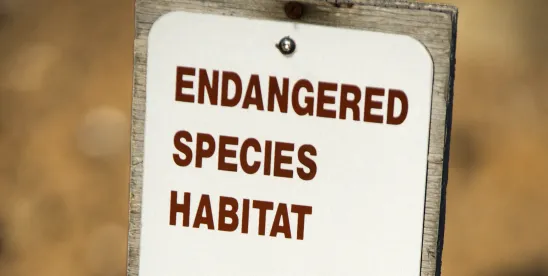The U.S. Fish and Wildlife Service (USFWS) and the National Marine Fisheries Service (NMFS) have proposed to rescind the regulatory definition of “harm” under the ESA to generally remove consideration of habitat when analyzing impacts to covered species. This move has potential to dramatically impact species conservation efforts and developer and landowner obligations under the Endangered Species Act (ESA), 15 U.S.C. §§ 1531-1541.
The two Services’ Notice of Proposed Rulemaking (NPRM), Rescinding the Definition of ‘‘Harm’’ Under the Endangered Species Act, 90 Fed. Reg. 16102 (April 17, 2025), would remove habitat modification as a basis for finding an unlawful “take” of a listed species under the Act.
Under current regulations—50 C.F.R. § 17.3 and § 222.102—“harm” is broadly defined to include not only direct injury or death of protected species, but also significant habitat modifications or degradation that kills or injures wildlife by significantly impairing essential behavioral patterns, such as breeding, feeding, or sheltering.
The proposed change would eliminate the regulatory definition of “harm” altogether and rely instead on the statutory definition of “take” in section 3(19) of the ESA, 16 U.S.C. § 1532(19). The statutory definition of “take” includes “harm” among a list of 10 actions that cause direct physical injury or death of listed species and include trapping, capturing, or collecting, among others. Habitat-related impacts, unless they are directly and physically harmful to animals, do not fall within the statutory definition.
The two Services offer three justifications for the proposed rule change:
- restoring clarity and predictability for regulated entities, like landowners and developers, who have argued that the current interpretation sweeps too broadly and creates uncertainty;
- realigning the definition with pre-1999, narrower interpretations of “take”; and
- reducing litigation risk by minimizing reliance of indirect theories of injury.
Meanwhile, critics of the NPRM charge that it would:
- dramatically weaken protection of endangered and threatened species by ignoring the importance of habitat loss;
- contradict longstanding judicial interpretations, including the Supreme Court’s decision in Babbitt v. Sweet Home Chapter of Communities for a Great Oregon, 515 U.S. 687 (1995), where the Court upheld the agencies’ authority to define “harm” to include significant habitat modification; and
- would increase species extinction risk by preventing early intervention when habitat destruction imperils survival but before physical injury begins.
If finalized, the proposed change may spawn vigorous debate and litigation. While in last term’s Loper Bright Enterprises v. Raimondo, 603 U.S. 369 (2024), the Supreme Court overruled the longstanding Chevron principle of agency deference in rulemaking, it remains to be seen how and whether it defers to its own past interpretation of “harm” in Babbitt. If the proposed rescission becomes final, the rule change would make it more difficult for the government and citizen groups to bring enforcement actions based on habitat destruction alone and shift the focus of ESA compliance to proving physical harm to individual animals rather than preventing ecological harm.
Comments on the NPRM are due May 19, 2025.



 />i
/>i


